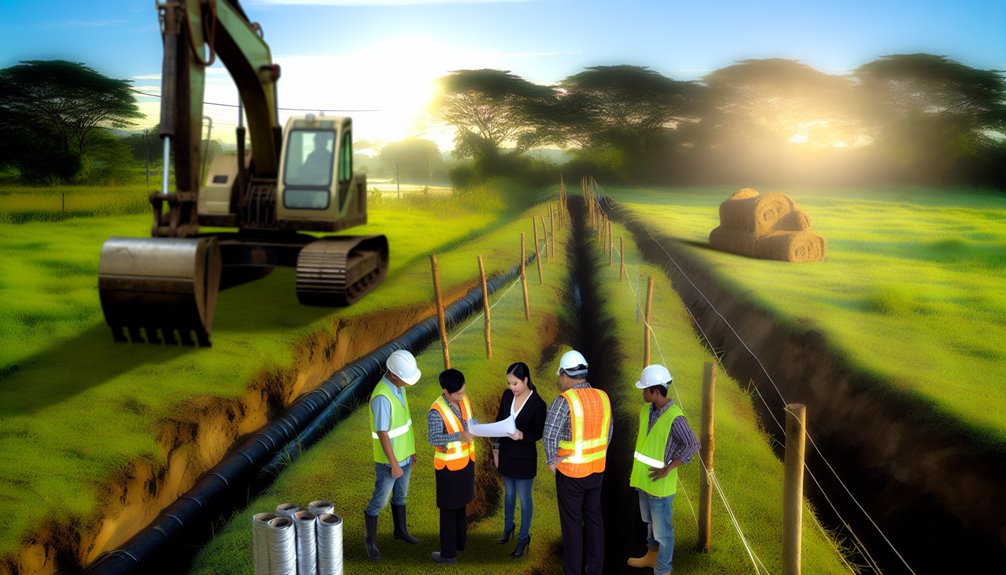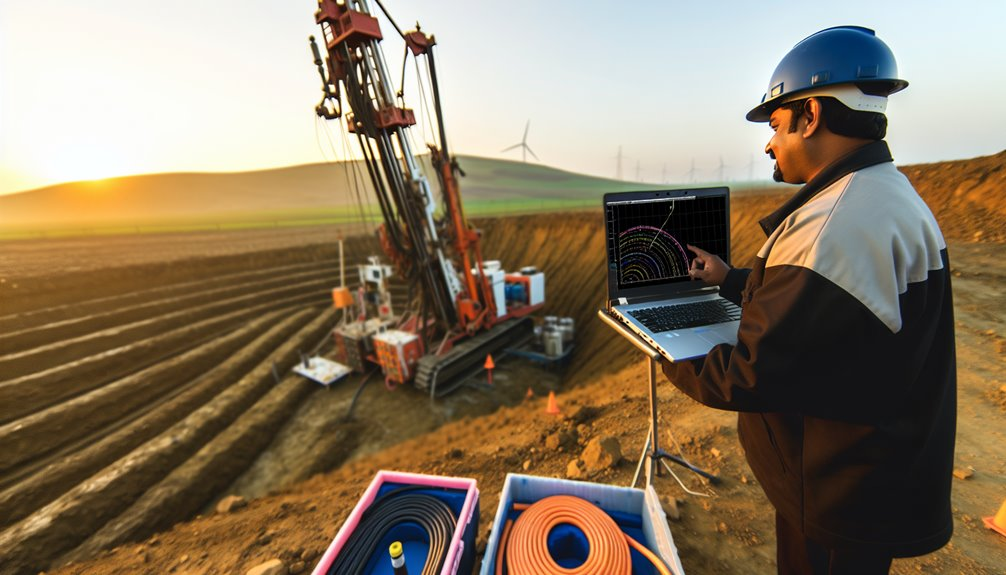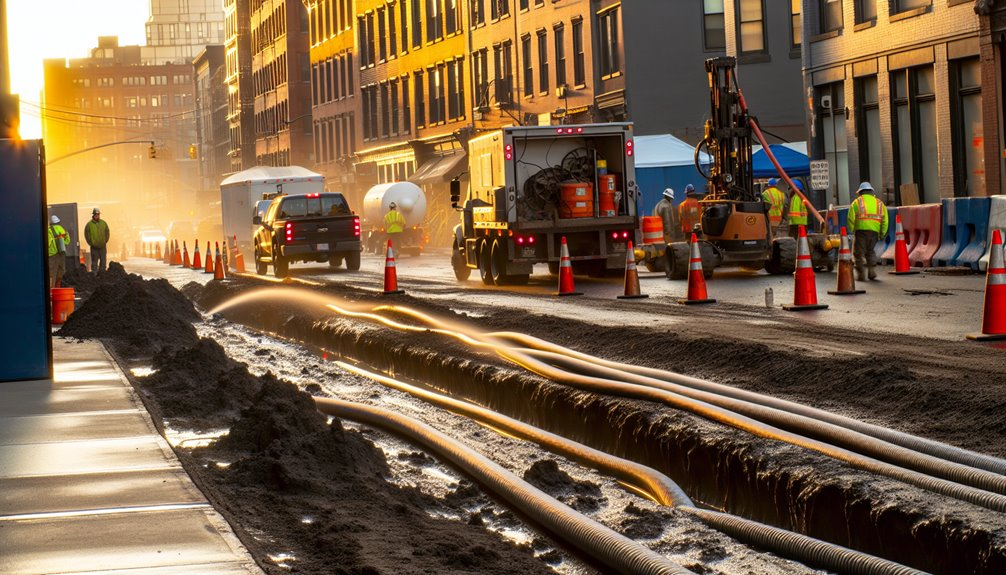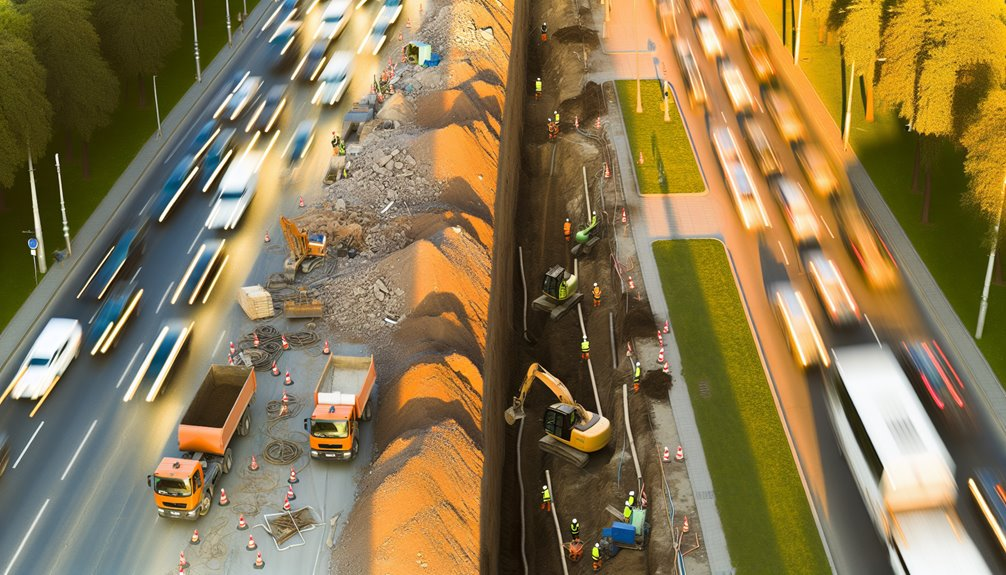When you commence a trenching project, it's essential to contemplate how your actions could impact local ecosystems. By conducting environmental impact assessments, you're not just complying with regulations; you're actively preserving wildlife habitats and maintaining ecological balance. This approach guarantees that your project minimizes disruptions and fosters sustainable development. Let's explore how integrating advanced trenching technologies and strategic planning can greatly reduce your environmental footprint, prompting a broader discussion on ecological responsibility in construction practices.
Assessing the Impact on Local Wildlife and Habitats
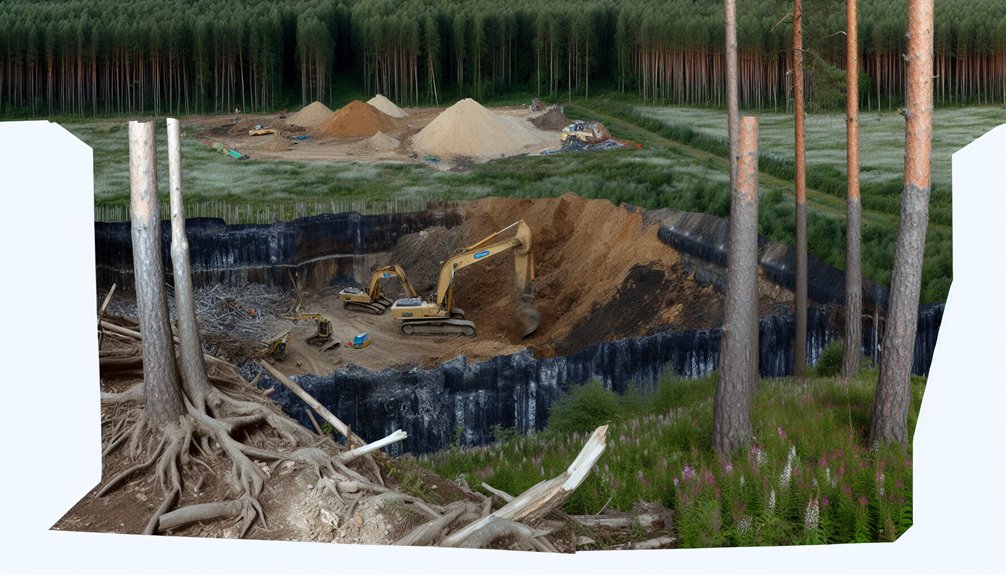
Before initiating any trenching activities, it's vital to conduct thorough environmental impact assessments to gauge potential effects on local wildlife and habitats.
You'll need to analyze how the excavation might disrupt wildlife corridors, which are essential for maintaining habitat connectivity. By collaborating with ecologists, you can map these corridors and adjust your project's layout to minimize fragmentation.
Detailed studies of air and water quality, as well as noise pollution, will further guarantee that your operations comply with stringent environmental regulations.
Implementing mitigation strategies, such as adjusting the timing of excavation to avoid breeding seasons, will protect sensitive species. Additionally, employing specialized, low-impact trenching equipment can further reduce the ecological footprint of your project specialized equipment.
These measures not only foster biodiversity but also uphold your commitment to sustainable practices.
Soil Erosion and Stability Challenges
You'll face significant challenges in identifying erosion-prone areas, which is essential for planning effective trenching services. Techniques for soil stabilization, such as employing retaining walls or advanced grading, play a pivotal role in maintaining the integrity of your project site. Additionally, understanding the impact on surrounding landscapes helps in mitigating adverse effects and promotes sustainable construction practices. Specialists in this field possess a comprehensive understanding of how to implement these measures effectively to ensure stability and prevent potential environmental hazards.
Identifying Erosion Prone Areas
Why should we focus on identifying erosion-prone areas?
You're dealing with a complex interplay of soil types, climate influence, and human activities that notably heighten erosion risks. Areas with steep slopes and disturbed soils, often found near construction sites, are particularly vulnerable. This susceptibility is exacerbated by poor watershed management and land use practices that fail to mitigate impacts of sediment transport.
Furthermore, regions with sparse vegetation experience increased erosion, as natural barriers to soil displacement are diminished. Understanding these dynamics is essential for implementing effective erosion control measures.
Techniques for Soil Stabilization
To effectively combat soil erosion and enhance stability in trenching projects, several soil stabilization techniques have been developed.
You can utilize mechanical stabilization techniques such as grading, compaction, and blending with other materials to modify soil properties. Grading achieves the desired slope, while compaction increases soil density, improving its load-bearing capacity. Blending enhances soil strength and stability.
Chemical stabilization methods involve adding agents like lime, cement, or fly ash. Lime reduces the plasticity of clay soils, cement creates a durable soil matrix, and fly ash improves structural integrity.
Together, these approaches limit soil's susceptibility to erosion and weathering, ensuring the longevity and safety of your trenching projects.
Impact on Surrounding Landscapes
Building on the stabilization techniques discussed earlier, it's important to contemplate how trenching activities impact the broader environment, particularly concerning soil erosion and stability challenges.
You'll find that excavation not only disturbs the soil structure but also exacerbates erosion through increased water runoff and sedimentation. This process threatens the surrounding landscapes, leading to instability and loss of fertile topsoil.
Implementing landscape restoration and vegetation preservation is vital. By integrating robust erosion control measures such as sediment barriers and proper drainage systems, you help mitigate these adverse effects.
Additionally, adopting an erosion and sedimentation control plan guarantees that the soil remains stable and fertile, supporting sustainable development and ecological balance in your projects.
Minimizing Water Contamination During Trenching

As trenching operations commence, minimizing water contamination is essential to protect local waterways and maintain environmental integrity. Your focus on trench water management and contamination prevention is critical.
Here are key strategies:
- Pre-treatment Components: Install settling basins to capture sediment before it enters watercourses.
- Overflow Systems: Design overflow facilities to handle excess stormwater, reducing the risk of uncontrolled runoff.
- Stormwater Controls: Utilize underdrain systems and gravel layers to enhance infiltration and filter pollutants.
- Barrier Implementation: Place silt fences and fiber rolls strategically around the site to prevent sediment-laden water from escaping.
- Regular Maintenance: Confirm features like oil/grease traps are inspected and cleaned regularly to prevent pollutant discharge into the environment.
Implementing these measures will greatly reduce the risk of water contamination.
Adhering to Environmental Laws and Regulations
As you undertake trenching projects, it's essential to comply with legal standards to guarantee you're not violating environmental laws.
Your operations can greatly impact local ecosystems, necessitating strategies to mitigate pollution risks effectively. This involves not only adhering to permit requirements but also implementing rigorous environmental impact assessments and site-specific pollution controls.
Compliance With Legal Standards
To guarantee the environmental integrity of trenching operations, strict adherence to various legal standards is essential.
As you navigate the regulatory frameworks, understanding and implementing environmental compliance is vital. Here are specific areas to focus on:
- Air Quality: Use dust suppression systems and monitor emissions from machinery to adhere to the Clean Air Act.
- Water Quality: Implement erosion controls and manage stormwater to comply with the Clean Water Act.
- Waste Management: Sort and recycle materials, ensuring hazardous waste meets Resource Conservation and Recovery Act standards.
- Soil and Ground Protection: Classify soil accurately and conduct daily trench inspections to prevent environmental hazards.
- Energy Use: Opt for clean energy sources to minimize emissions during trenching activities.
Impact on Local Ecosystems
While compliance with legal standards forms the framework for environmentally responsible trenching practices, the direct impact on local ecosystems demands equally rigorous attention.
You must prioritize habitat preservation by mapping ecological features to guide the excavation process effectively. Efforts to transplant endangered or sensitive species are vital, guaranteeing wildlife relocation to safe, unaffected areas.
Utilizing specialized equipment can minimize the physical footprint, significantly preserving the structural and functional integrity of habitats like wetlands.
Planning trenching activities around wildlife life cycles—particularly avoiding breeding and migration periods—further mitigates negative impacts, maintaining ecosystem continuity.
This proactive approach not only adheres to regulations but also secures the sustainability and resilience of local ecosystems.
Mitigating Pollution Risks
Understanding the environmental risks associated with trenching operations, it's crucial you initiate pre-construction planning and preparation to mitigate pollution risks effectively.
By conducting detailed ecological assessments, you can identify potential pollution sources, guaranteeing robust pollution prevention strategies are in place.
- Conduct thorough site assessments to pinpoint pollution pathways and sources.
- Develop and implement Extensive Environmental Management Plans (EEMPs) that detail proactive mitigation strategies.
- Secure all necessary environmental permits before breaking ground to guarantee legal compliance.
- Install barriers and sediment controls like silt fences and berms to manage stormwater and prevent runoff.
- Regularly monitor and inspect the site, adjusting measures as required to maintain a high standard of environmental safety.
Adhering to these practices is crucial for minimizing environmental impact.
Innovative Trenching Technologies for Reduced Ecological Footprint

How can trenching services minimize their environmental impact? By integrating innovative trenching technologies, you can greatly reduce your ecological footprint.
Trenchless technology stands out, preserving ecological balance by minimizing excavation and soil disturbance. This method not only limits soil erosion but also protects natural vegetation and reduces habitat disruption.
Furthermore, by decreasing the use of heavy machinery, trenchless techniques reduce air pollution and greenhouse gas emissions. You'll also see a reduction in noise pollution, enhancing the quality of life for nearby communities.
Additionally, these technologies promote the efficient use of resources, generating less waste and necessitating fewer raw materials.
Strategies for Waste Management and Recycling
Effective waste management and recycling strategies are essential for minimizing the environmental impact of trenching services. You need to plan carefully and employ innovative recycling technologies to handle the diverse waste generated.
Here are some key actions to visualize:
- Assess and Plan: Estimate waste types and volumes; create a detailed management plan.
- Segregate Ruthlessly: Use designated containers for metals, woods, and concrete, enhancing waste segregation.
- Build Strong Partnerships: Forge relationships with local recycling and disposal facilities.
- Educate and Train: Continually train your team on updated recycling practices.
- Innovate Continuously: Explore and adopt advanced recycling technologies that keep you ahead in sustainability.
Community Engagement and Environmental Awareness
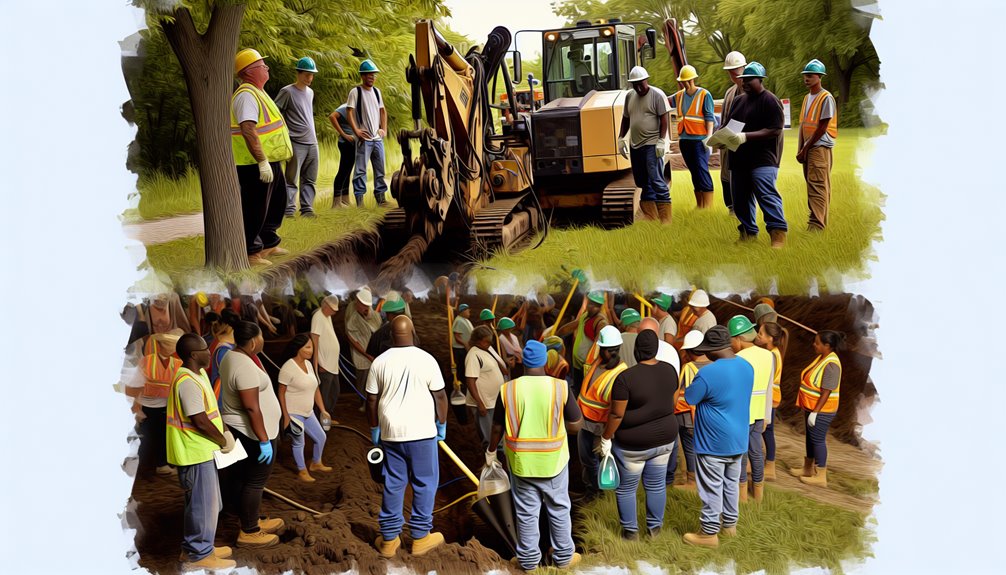
While waste management is essential, building robust community engagement and fostering environmental awareness are equally important to the success of trenching services.
By integrating community workshops and eco-friendly initiatives, you're not just complying with regulations; you're actively enhancing community resilience and ownership.
These workshops often focus on disaster preparedness and sustainable practices, which are critical in areas affected by trenching and land reuse.
Additionally, engaging local schools and businesses in these efforts not only strengthens community ties but also boosts the adoption of eco-friendly technologies by 40%.
This approach guarantees that the projects align with community needs, making them more sustainable and accepted, thereby transforming environmental challenges into opportunities for collective growth and innovation.
Monitoring and Mitigating Noise and Air Pollution
Given the substantial impact of noise and air pollution during trenching operations, it's crucial to implement thorough monitoring and mitigation strategies.
You'll need to adopt innovative noise measurement techniques and sound barrier designs to efficiently manage these environmental challenges.
- Identify all major noise sources such as drilling and excavating, evaluating their proximity to sensitive areas.
- Utilize advanced sound barriers, incorporating materials like vinyl-coated polyester to effectively reduce noise by up to 15 dB.
- Monitor noise levels continuously with precise instruments to verify they don't exceed regulatory limits.
- Schedule noisy operations strategically to minimize their impact during sensitive times.
- Implement quieter construction technologies and methods, reducing the overall noise footprint of the operation.
Long-term Environmental Planning and Management
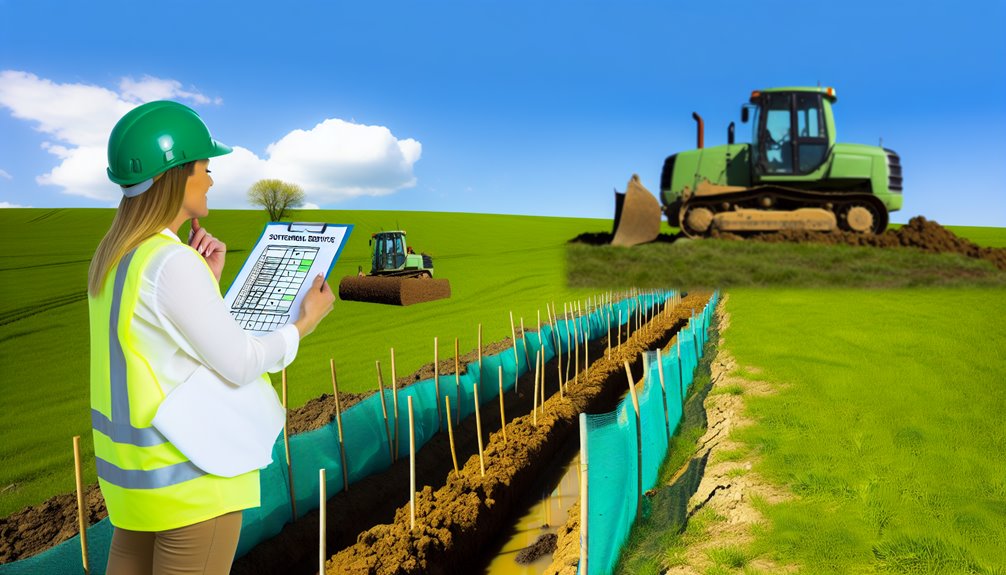
After addressing measures to control noise and air pollution in trenching operations, it's necessary to focus on broader strategies that guarantee long-term environmental health and compliance.
In your long-term planning, consider the coordinated integration of remediation and site usage to ascertain sustainable practices are foundational, not afterthoughts.
By optimizing groundwater treatment and reducing fuel consumption, you'll not only cut carbon emissions but also diminish reliance on fossil fuels.
Implement onsite treatment of soil and sediment to minimize offsite transport—this reduces your carbon footprint and supports local ecosystems by avoiding extensive disturbances.
Furthermore, restoring native species and employing evapotranspiration covers can enhance local habitats and ascertain compliance with environmental regulations, securing the site's ecological future while maintaining legal and safety standards.
Conclusion
As you plan your trenching projects, it's essential to integrate environmental considerations at every step. Evaluating impacts on wildlife and habitats, minimizing soil erosion, and preventing water contamination are imperative. You'll need to comply with environmental laws and embrace innovative, low-impact technologies. Effective waste management, community engagement, and stringent monitoring of noise and air pollution are also fundamental. By prioritizing long-term environmental management, you'll not only adhere to regulations but also foster community trust and sustainability.
If you're looking to learn more about how to implement these best practices in your trenching projects, I invite you to visit Boring Bros at boringbro.com. You can also give us a call at (954) 639-6167. We're here to help, and we'd love to chat about how we can support your efforts in creating a more sustainable future!

